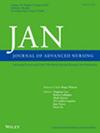从社会网络类型的角度探讨青壮年主观认知能力下降及其相关因素
IF 3.4
3区 医学
Q1 NURSING
引用次数: 0
摘要
目的根据青壮年社会网络结构特征,识别青壮年社会网络的不同类型,并探讨不同类型、社会人口特征与主观认知能力下降之间的关系。DesignA横断面研究于2022年7月至2023年10月进行。方法对652名60 ~ 74岁的中老年成人进行社会人口学问卷、主观认知能力下降问卷- 9和自行设计的自我中心社会网络问卷。社会网络类型通过潜在特征分析进行识别。采用单因素分析和二元logistic回归分析主观认知能力下降的影响因素。结果主观认知能力下降的发生率为38%。青壮年的社会网络往往很大,主要以家庭为中心,网络成员之间的联系强度强,密度高,人口异质性显著。我们确定了四种社会网络类型:多元-适度、家庭-密集、家庭-强大和朋友-松散。家庭密集型和家庭强型的年轻老年人比多元温和型的老年人更容易出现主观认知能力下降。此外,年龄、受教育程度、以前的职业、每日睡眠时间和运动与主观认知能力下降的发生率有关。结论:研究结果表明,青壮年主观认知能力下降的发生率相对较高,这明显受到他们所处社会网络类型的影响。需要重视对主体性认知能力下降高危人群的识别和支持,特别是促进其社会融合和朋友网络建设,以改善其主体性认知功能。对专业和/或患者护理的影响研究结果强调了在解决年轻-老年人主观认知能力下降问题时考虑社会网络结构和组成的重要性。包含家庭和友谊关系的多元化社会网络可能提供增强的认知保护。因此,针对主观认知能力下降的干预措施应该促进以友谊为基础的关系的扩展,并促进更多异质和多源网络的发展。报告方法:strobe核对表。患者或公众捐款不适用。本文章由计算机程序翻译,如有差异,请以英文原文为准。
Exploring Subjective Cognitive Decline and Its Related Factors Among Young‐Old Adults: A Perspective on Social Network Types
AimsTo identify distinct social network types among young‐old adults based on the characteristics of social network structure and to explore the relationship between different types, socio‐demographic characteristics and subjective cognitive decline.DesignA cross‐sectional study was conducted from July 2022 to October 2023.MethodsA total of 652 young‐old adults aged 60–74 years completed the sociodemographic questionnaire, the subjective cognitive decline questionnaire‐9 and the self‐designed egocentric social network questionnaire. The types of social networks were identified by latent profile analysis. Univariate analysis and binary logistic regression were used to analyse the influencing factors of subjective cognitive decline.ResultsThe incidence of subjective cognitive decline was 38%. Social networks of young‐old adults tended to be large, predominantly family‐centred and characterised by strong contact strength, high density and significant demographic heterogeneity among network members. Four social network types were identified: diverse‐moderate, family‐dense, family‐strong and friend‐loose. Young‐old adults embedded in the family‐dense and family‐strong types were more likely to develop subjective cognitive decline than those in the diverse‐moderate type. Additionally, age, education level, previous occupation, daily sleep duration and exercise were related to the incidence of subjective cognitive decline.ConclusionsThe findings highlight the relatively high incidence of subjective cognitive decline in young‐old adults that is notably influenced by the type of social network they are embedded in. More attention needs to be paid to identifying and supporting young‐old adults at high risk of subjective cognitive decline, especially to promote their social integration and friend network building, to improve their subjective cognitive function.Implications for the Profession and/or Patient CareThe findings emphasise the importance of considering the structure and composition of social networks when addressing subjective cognitive decline among young‐old adults. A diversified social network incorporating both familial and friendship ties may provide enhanced cognitive protection. Therefore, interventions targeting subjective cognitive decline should promote the expansion of friendship‐based relationships and foster the development of more heterogeneous and multi‐source networks.Reporting MethodSTROBE checklist.Patient or Public ContributionNot applicable.
求助全文
通过发布文献求助,成功后即可免费获取论文全文。
去求助
来源期刊
CiteScore
6.40
自引率
7.90%
发文量
369
审稿时长
3 months
期刊介绍:
The Journal of Advanced Nursing (JAN) contributes to the advancement of evidence-based nursing, midwifery and healthcare by disseminating high quality research and scholarship of contemporary relevance and with potential to advance knowledge for practice, education, management or policy.
All JAN papers are required to have a sound scientific, evidential, theoretical or philosophical base and to be critical, questioning and scholarly in approach. As an international journal, JAN promotes diversity of research and scholarship in terms of culture, paradigm and healthcare context. For JAN’s worldwide readership, authors are expected to make clear the wider international relevance of their work and to demonstrate sensitivity to cultural considerations and differences.

 求助内容:
求助内容: 应助结果提醒方式:
应助结果提醒方式:


